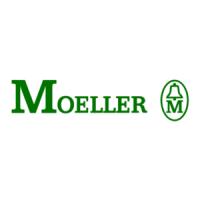
Do you have a question about the Moeller DF6-340-15K and is the answer not in the manual?
Essential safety precautions and steps to take before starting the installation process.
Explains how to connect the DF6 frequency inverter to the mains power supply safely and correctly.
Outlines the necessary measures and standards for ensuring electromagnetic compatibility of the DF6 inverter.
Covers the procedures and considerations for mounting the DF6 frequency inverter correctly.
Details the mechanical steps for securely mounting the DF6 frequency inverter using screws.
Explains how to achieve EMC compliance through proper installation and filter usage.
Recommends measures for an EMC-compliant setup, including enclosure and cable management.
Guides on the correct installation and connection of radio interference filters for EMC compliance.
Details essential earthing procedures for metallic enclosures and components for EMC safety.
Describes how to implement EMC measures within a control cabinet for optimal performance.
Provides comprehensive instructions for making all necessary electrical connections to the inverter.
Key checks and steps to perform before powering on and operating the frequency inverter.
Describes the physical layout and functions of the DF6's LCD keypad for operation.
Explains how to navigate and use the LCD keypad for parameter settings and inverter operation.
Guides on how to modify display parameters and basic settings using the keypad.
Details the process for adjusting parameters within extended function groups for advanced configuration.
Lists critical warnings and precautions to observe during operation to prevent damage or injury.
Describes how to select up to 16 user-definable fixed frequencies using digital inputs.
Details how to access up to seven fixed frequencies directly using digital inputs configured as SF1-SF7.
Explains how to configure digital inputs for controlling motor start, stop, and direction.
Instructions for configuring a digital input for clockwise motor operation and start/stop control.
Instructions for configuring a digital input for anticlockwise motor operation and start/stop control.
Explains how the start signal is issued, whether via digital inputs or the keypad's ON key.
Describes how to activate a second acceleration/deceleration time using a digital input.
Explains how to use the FRS input to stop the motor by coasting or controlled deceleration.
Details how to use an external fault signal to trigger a fault message and stop the inverter.
Explains the USP function to prevent automatic motor restarts after power interruptions.
Describes how to acknowledge fault messages and reset the frequency inverter using the RST input.
Explains how to operate the motor in jog mode for manual setup and positioning tasks.
Details how to protect configured parameters from unintentional changes using the SFT input.
Explains how to use digital inputs to control acceleration, deceleration, and frequency reset.
Describes how to use a second set of parameters for operating different motors or configurations.
Explains how to activate DC braking for the motor using a digital input or automatic frequency detection.
Details how to define and switch between different overload limits for motor protection.
Describes the CS function for starting drives with very high starting torque directly from the mains.
Explains how to use the keypad for defining setpoint values and controlling operation.
Details how to configure digital inputs for three-wire control of start, stop, and direction.
Explains how to activate/deactivate PID control and reset the PID integral component using digital inputs.
Explains how to configure a relay output to signal when the motor current exceeds a set threshold.
Describes how to configure a relay output to signal when PID control deviation exceeds a set threshold.
Explains how to configure a relay output to signal when a fault condition occurs in the inverter.
Details how to assign relay outputs for instant stop and undervoltage monitoring signals.
Explains how to configure a relay output to signal motor thermal overload conditions.
Describes methods for adjusting start signal and basic frequency parameters.
Explains how to define the frequency setpoint value using various input methods.
Specifies how the start signal is issued, via digital inputs, keypad, or serial interface.
Explains the DC braking function for decelerating the motor and related parameters.
Explains reduced tripping current settings for increased overload protection.
Describes the default normal overload protection tripping characteristic.
Guides on freely selecting tripping characteristics by defining frequency and current coordinates.
Sets motor current limit behavior during acceleration and static operation.
Defines the tripping current threshold for motor current limitation.
Specifies the time for frequency reduction when the current limit is reached.
Sets motor current limit behavior for a second instance, activated via OLR input.
Defines the tripping current threshold for the second instance of motor current limitation.
Specifies the time for frequency reduction for the second current limit instance.
Provides guidance on diagnosing and resolving issues when the motor fails to start.
Helps troubleshoot discrepancies between the set frequency and actual drive speed.
Addresses issues where entered parameter values are not saved correctly by the inverter.
Guides on resolving situations where keypad or input functions become unresponsive.
Helps diagnose and resolve faults related to the electronic motor protection system.
Specifies recommended cable cross-sections and fuse ratings for mains connection and motor wiring.
Lists recommended mains contactors and their ratings based on DF6 phase current.
Provides information on assigned mains chokes to reduce harmonics and protect the inverter.
Details radio interference filters, their matching inverters, and electrical specifications.
Selects between binary or bitwise selection methods for fixed frequency inputs.
